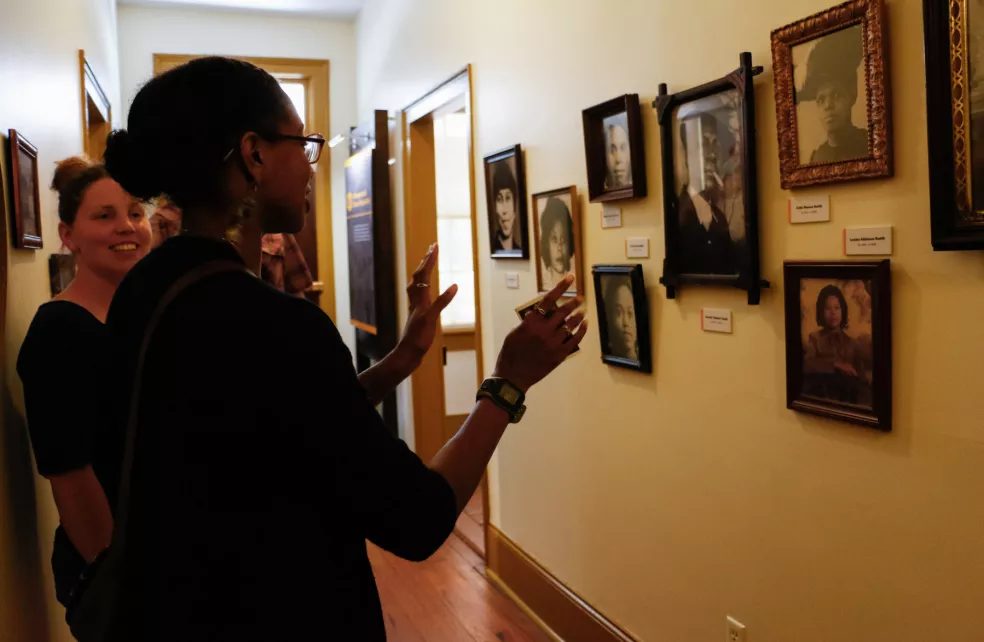Capital Women: Of Strength, Courage and Wisdom
Saturday, February 10th 2018

In 2016, Historic Columbia reopened the Mann-Simons Site with newly installed exhibits, interactive touchscreens, recorded audio and numerous visuals – enhancing the overall experience for each guest.
I recently had the opportunity to take a tour and was blown away by the comprehensive updates Historic Columbia had incorporated into the renovation. Each and every display came to life, allowing me to better understand the people, places and stories directly associated with the house I had entered and was exploring.
Two such women the tour discussed are Celia Mann, and her eldest daughter, Agnes Jackson. Both – and so many more – laid substantial and necessary groundwork for African American women, and African American’s in general. I wanted to highlight their stories by sharing my tour experience. My hope is that this story will encourage you to visit the site and help further broaden Historic Columbia’s message regarding the importance of history, preservation and progress.
Celia Mann
On the way to the Mann-Simons Site, I made a concerted effort to turn off my normally hectic inner dialogue, so I could fully engage in the experience I was stepping into. Because the site was undergoing a renovation, slated to reopen with new interactive and social components in a few months, I had the privilege of having a personal tour with a few representatives from Historic Columbia. Historic Columbia manages, maintains and preserves five historic landmark sites in downtown Columbia. Starting the tour outside, I was immediately introduced to the woman for whom the site got its namesake. I did not realize at the time, but later grasped, I would forever remember – Celia Mann.
One of the first things discussed was the fact that Celia was once enslaved in Charleston, South Carolina. After managing to purchase her freedom, she, as well as her husband, Ben Delane, left Charleston and ended up settling in Columbia. Around the property were various ghost structures – steel frames outlining and representing buildings her future family members would own and occupy. Hearing this information gave me chills. The will and resourcefulness to not only survive enslavement, but face odds to make a life for herself, her family and posterity better, as a newly freed African American woman in the divided and very broken South, was somewhat unimaginable.
We made our way around the side and then to back of the house, finally stepping inside the site. With the wood beams creaking and cracking under our feet, we started our way through the interior. Period pieces and replica furniture told of times past; simple, yet obviously difficult and constantly trying. In the front room, I was told of Celia’s profession as a midwife, a position traditionally held in high regard throughout the community. She, for years, cared for the needs of both white and African American families, in addition to caring for her own children and family. I did not say much as we kept moving through the home, but I could not help putting myself in Celia Mann’s shoes. Her strength – mental, physical and spiritual – was endless.
Agnes Jackson
As we walked in the last room on the tour, the conversation shifted to the latter part of Celia’s life and her offspring. I stood there, taking in the information, when one note caught my eye. It made mention of Celia’s passing stating, “The Daily Phoenix publishes note saying: “Death of a Respected Colored Woman—Celia Mann, an old and respected colored nurse, who was present at the birth of many of our citizens, departed this life yesterday.” A flood of mixed emotions came over me when realizing this formerly enslaved woman had finally received the respect she so deserved. A caged song bird for so many years, finds the will to escape, and soar – not because of that recognition or their acceptance, but because she sought better for herself and her family and achieved what so many came up short in trying to do. It was a true testament to her unwavering perseverance.
While Celia had four daughters, the majority of information presented focused on her youngest, Agnes Jackson. Embodying many of the same traits and qualities as her inspirational mother, Agnes, aided Celia and her family on the site we were standing, in downtown Columbia at the corner of Richland Street. A few years prior to Celia’s death in 1867, Agnes moved in to assist with family matters.
Following in the similar business-minded footsteps of her mother, Agnes provided for her family by becoming a skilled baker and a laundress. Standing tall as another example of a fearless, headstrong and determined African American women, Agnes served in all respects of the word as the ‘head of the household,’ raising, shaping and being an example to her six children – one of which, John Lucius Simons, went on in later years to open a thriving lunch counter on the grounds.
Driving home I couldn’t help but think back on these truly phenomenal women. I knew it was grossly unfair for me to compare my life, my current situation and my circumstances to theirs, however my mind wandered there. Could I have done what they did? Endured what they endured? Pushed as hard as they pushed if the roles were reversed? While I’ll never know the answers to those questions, I could say with complete certainty that I was incredibly thankful to know more about what they overcame for me and my family, my future and for those generations to come. Having had that greater exposure to this particular history, I, by principal, could never forget it. It was imperative I remember it and carry it with me each day. After all, I was one for whom these women fought for.
Learn More
Learn more about these incredible women by taking a tour of the Mann-Simons Site today!